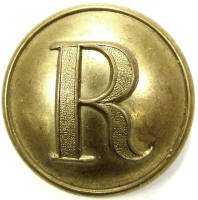
A virtual examination of artifacts of the American Civil War
 |
Ridgeway Civil War Research Center, A virtual examination of artifacts of the American Civil War |
| Civil War Artillery | |
| by Harry Ridgeway |
| Rifled artillery projectile, Tennessee design, Confederate manufacture, solid bolt, forged iron smooth sides blunt nose, copper disc sabot with 3 studs in the sabot and flush mounted bolt, Confederate rifled 12 pounder rifle, 4.62 in. Projectile was Confederate manufactured and was originally believed to have been developed by Mullane working with Read and others, however, updated research has not been able to confirm the existence of a man named Mullane. Period literature often refers to work as the "Tennessee" design, cup, or sabot, and is attributed to Captain Lardner Gibbon, although official recognition for his development was never granted. This pattern was manufactured from rolled or forged steel, the rolling seams are clearly visible leaving rough sections. This would produce a harder steel than cast iron, and might have been more effective against the ironclads, however it was probably too labor extensive and expensive to produce, so few were produced. The sabot system utilized was a copper disc held in place by studs and secured with a center bolt, a manufacturing innovation allowing the parts made of different metals, copper and iron, to be prepared independent and assembled at the end. This sabot pattern, referred to as Type II, employed three short studs cast into the sabot and fitted into holes drilled on the bottom of the shell, then secured with a center bolt. Performance of this sabot was unsatisfactory, typically the studs or the bolt would break on firing releasing or distorting the copper disc sabot. Projectile measures: diameter 4.53in., length 9in. excluding fuze, weight 35.7lbs. Research Center: Artillery5851-Tennessee, Ref: Bell Heavy Ordnance, pg. 405. Details click: http://relicman.com/artillery/Artillery5851-Tennessee.html. |
| Ridgeway Civil War Research Center, A virtual examination of artifacts of the American Civil War. Artillery Research center, artillery, click: http://relicman.com/artillery/Artillery0000-Index.html. Research center, artillery, click: http://relicman.com/artillery/Artillery0000-Index.html. |
| Civil War Relicman, Harry Ridgeway, Civil War artillery, Relicman sales catalog. Click here: http://relicman.com/artillery/RelicmanSalesArtillery1.html. Artillery for sale: http://relicman.com/artillery/RelicmanSalesArtillery1.html. |